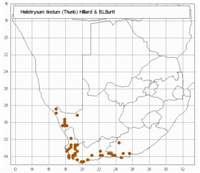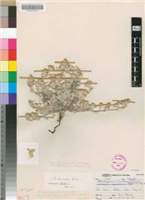Origin of name:
tincti = dyed, stained, tinged
Diagnostic characters:
Branches prostrateSmall roundish leavesStraw-coloured bracts, often tinged red, with long thin tipsWhite woolly plant
Description:
Prostrate or diffuse grey- or sometimes white-woolly herb, possibly annual, main branches 40-450 mm long, many from the crown, congested or lax, much branched above, loosely woolly, leafy. Leaves mostly 7-20 x 4-8 mm, spathulate to elliptic-spathulate, obtuse, base narrowed, margins flat, both surfaces woolly-felted, uppermost leaves, particularly those surrounding the heads, often folded lengthwise and recurved. Heads homogamous or rarely heterogamous, campanulate, 5-6 x 3-4 mm, sometimes solitary, mostly c. 3-12 crowded in small glomerules terminating the branchlets. Involucral bracts in 4 series, outer short, webbed with wool to surrounding leaves, inner subequal, exceeding flowers, soon caducous, colour very variable, pale straw to deep straw to golden brown or crimson, or combination of these colours, tips very acute to acuminate, opaque, strongly hooked, concolorous or colour contrasting with that of shaft. Receptacle nearly smooth. Flowers 13-27, 2-3 occasionally female. Achenes not seen, ovaries with myxogenic duplex hairs, or very rarely glabrous. Pappus bristles many, in several series, equaling corolla, delicate, scabrid, bases cohering by patent cilia.
Flowers mainly between September and November.
Distribution:
Ranges from Springbok, the Kamiesberg and the mountains about Piquetberg and the Cedarberg across the high ground and mountains, including Table Mountain, to the Great Winterhoek Mountains and Kruisfontein Mountains near Humansdorp, mainly between 250 and 1 350 m above sea level, with one isolated record (Acocks 21780) from the Camdeboo plateau near Aberdeen at 1 675 m.
Fynbos, Succulent Karoo, Nama Karoo and Thicket Biomes.
Notes:
H. tinctum is characterized by its acuminate, hooked involucral bracts and hairy ovaries; only very rarely are the bracts emarginate. The type of Leontonyx bicolor seems to be no more than an extreme variant with solitary or 2-3 heads at the branch tips.
Taxonomy:
Literature:
Helichrysum tinctum (Thunb.) Hilliard & Burtt in Bot. J. Linn. Soc. 82, 3: 200 (1981).
Type:
Cape of Good Hope, Thunberg (sheet 19276, UPS, holo.).
Synonym(s):
Gnaphalium tinctum Thunb., Prodr. 151 (1800), Fl. Cap. 656 (1823). Leontonyx coloratus Cass. in Dict. Sci. nat. 25: 467 (1822). Spiralepis tincta (Thunb.) D. Don, l.c. L. coloratus var. gracilis Less., Syn. Comp. 326 (1823).
G. glomeratum L., Pl. Rar. Afr. 20 (1760), Amoen. Acad. 6: 99 (1764), non Helichrysum glomeratum Klatt. Spiralepis glomerata (L.) D. Don in Mem. Worn, nat. Hist. Soc. 5: 552 (1826). Leontonyx glomeratus (L.) DC., Prodr. 6: 168 (1838); Harv. in F.C. 3: 206 (1865); Levyns in Adamson & Sailer, Fl. Cape Penins. 786 (1950). L. glomeratus var. verus Harv., l.c. Lectotype: South Africa (LINN 989.85).
Leontonyx stramineus DC., Prodr. 6:168 (1838), non Helichrysum stramineum Hiern. L. glomeratus var. stramineus (DC.) Harv., l.c. Type: Cape, Piquetberg, Dr�ge 6338 (G-DC, holo.).
L. bicolor DC., l.c., non Helichrysum bicolor Lindl. Type: Kamiesberg, Dr�ge 2838 (G-DC, holo.; S, iso.).
L. angustifolius DC. var. diffusus DC., l.c. Type: Cape, Drakensteenberg, Dr�ge 1790 (G-DC, holo.).
L. glomeratus var. intermedius Harv., l.c. Type: nothing cited.
Vouchers:
Acocks 19854 (PRE); Barker 7698 (NBG); Compton 6460 (NBG); Esterhuysen 19319 (BOL; PRE); Galpin 4146 (PRE).

